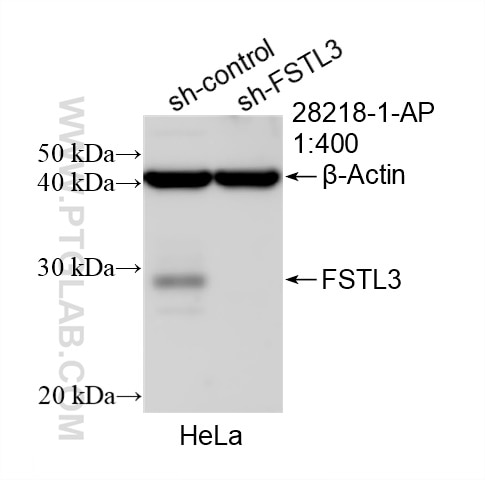- Phare
- Validé par KD/KO
Anticorps Polyclonal de lapin anti-FSTL3
FSTL3 Polyclonal Antibody for WB, ELISA
Hôte / Isotype
Lapin / IgG
Réactivité testée
Humain
Applications
WB, ELISA
Conjugaison
Non conjugué
N° de cat : 28218-1-AP
Synonymes
Galerie de données de validation
Applications testées
| Résultats positifs en WB | cellules HeLa, |
Dilution recommandée
| Application | Dilution |
|---|---|
| Western Blot (WB) | WB : 1:200-1:1000 |
| It is recommended that this reagent should be titrated in each testing system to obtain optimal results. | |
| Sample-dependent, check data in validation data gallery | |
Informations sur le produit
28218-1-AP cible FSTL3 dans les applications de WB, ELISA et montre une réactivité avec des échantillons Humain
| Réactivité | Humain |
| Hôte / Isotype | Lapin / IgG |
| Clonalité | Polyclonal |
| Type | Anticorps |
| Immunogène | FSTL3 Protéine recombinante Ag27626 |
| Nom complet | follistatin-like 3 (secreted glycoprotein) |
| Masse moléculaire calculée | 263 aa, 28 kDa |
| Poids moléculaire observé | 28-33 kDa |
| Numéro d’acquisition GenBank | BC005839 |
| Symbole du gène | FSTL3 |
| Identification du gène (NCBI) | 10272 |
| Conjugaison | Non conjugué |
| Forme | Liquide |
| Méthode de purification | Purification par affinité contre l'antigène |
| Tampon de stockage | PBS avec azoture de sodium à 0,02 % et glycérol à 50 % pH 7,3 |
| Conditions de stockage | Stocker à -20°C. Stable pendant un an après l'expédition. L'aliquotage n'est pas nécessaire pour le stockage à -20oC Les 20ul contiennent 0,1% de BSA. |
Informations générales
Follistatin‐like 3 (FSTL3) is a highly conserved 27-39 kDa monomeric glycoprotein belonging to the follistatin protein family and it is primarily expressed in the placenta as well as in the testis, heart, adipose tissue, and pancreas. It is an extracellular inhibitor of the transforming growth factor beta (TGF‐β) family ligands, including activin, myostatin, and bone morphogenetic proteins.
Protocole
| Product Specific Protocols | |
|---|---|
| WB protocol for FSTL3 antibody 28218-1-AP | Download protocol |
| Standard Protocols | |
|---|---|
| Click here to view our Standard Protocols |


